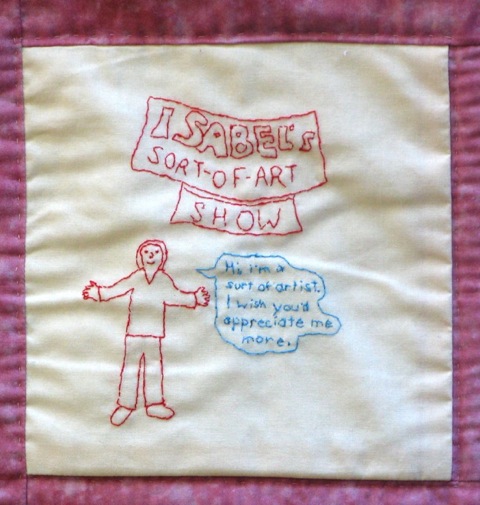A look at the latest Leigh Square show
By Julia Siedlanowska, Staff Writer
An all-female feminist exhibition that, according to the show’s program, “challenges the preconceived notions of female achievement in the arts and addresses the question of gender bias in the art world” is open now at Leigh Square. Curated by Danaca Ackerson and Deanna Fogstrom, How Nice to Have a Hobby features more than 15 female artists in this powerful and concise collection with an important message.
The variety of mediums, such as paintings, quilts, ceramics, photographs, and clothing, within the exhibit sets up a perfect field for discussions about art versus hobby. Mediums like quilting are often faced with scrutiny and skepticism about their validity, which may have something to do with their origins. With the women of the modern world traditionally being restricted to housework and hobby crafts (as is visible in the many artifacts of needlework), it’s no wonder that breaking into the art world may have posed some challenges.
Although “there have been incredible strides made,” according to the program for How Nice to Have a Hobby, “there’s a lot of work to be done yet.” While there are always questions about the value and validity of art, looking at this question through a lens of gender equality offers another important perspective.
Ackerson and Fogstrom were inspired to create the exhibition at Leigh Square in part because of a visit to the Seattle Art Museum’s 2012-13 exhibit Elles: Women Artists from the Centre Pompidou. The exhibit featured over 75 women artists and was all-female. Ackerson recalls that at the time the Pompidou was being reconfigured so that “the issue of gender bias wasn’t an issue anymore,” and that the exhibit was “trying to rectify the gender bias” in the art world. Some major inspiration, worthy of applying to local women artists in British Columbia.
With the intention of How Nice to Have a Hobby being “to generate conversations about high-/low-art, art/craft, dilettante/artist, gender bias, and the notion of hobby vs. profession,” nothing does it better than Sima Elizabeth Shefrin’s fabric piece titled “Isabel’s Sort-of-Art-Show.” The quilt features an almost comic strip-like depiction of a series of snapshots in this character’s life. The original sketch that inspired the piece actually was a short comic that depicted the artists own fears. “Isabel” (which is a slightly abstracted version of the artist’s own name) is seen creating her art and apologizing for it. In the end, she is small and defeated. This was my favourite piece in the show as it spoke on the subject in a clear and precise matter. The artist used humour in the piece to portray the problems many artists, not only females, face in their art. In an artist’s statement about the piece, Shefrin thanks all the strident feminist voices in the world and also states that “sometimes social change comes with a smile.” This was the quintessential embodiment of the themes in this exhibit, and it is worth seeing if just for this piece.
Other notable pieces were those by artist Karyn Wong. With her highly colourful paintings depicting women in an almost comic book graphic style, she is a great contrast to Shefrin. While Shefrin depicts women in a raw and lifelike way (lifelike meaning that the women in her work are taken from reality), Wong depicts women in a slightly idealized way. Her comic book women are depicted in situations with titles that suggest a political and social standpoint. Something is hidden there that is much more than a pretty face.
While there are many gender inequalities within professions, the art world is not exempt. According to the curators, there is a lot of work to be done within the realm of women’s equality. When accepting submissions, Ackerson said, “Our mandate was to be inclusive. We wanted to provide women with the opportunity to exhibit because it’s hard for women to have exhibits—as evidenced by the major galleries like the MOMA, the Guggenheim, big civic museums that have a very small percentage of work by women artists in their collection—like two to four per cent.”
I personally enjoyed the theme and would not mind seeing more exhibits like this. An exhibit that’s 100 per cent woman was quite all right with me.


